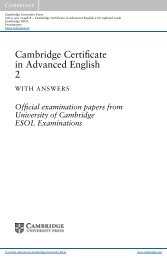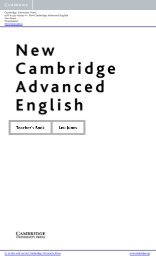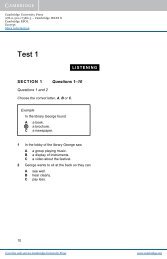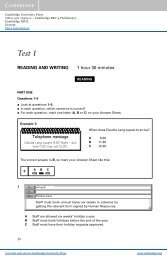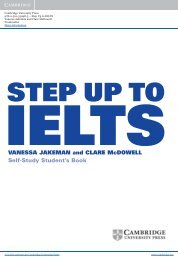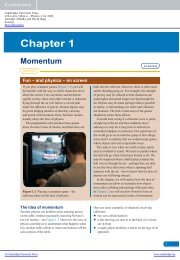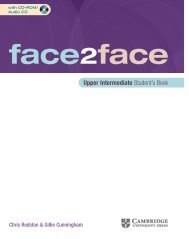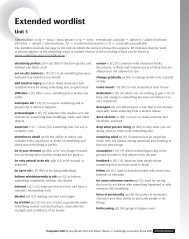Skills for Study Level 2 Teacher's Book - Cambridge University Press
Skills for Study Level 2 Teacher's Book - Cambridge University Press
Skills for Study Level 2 Teacher's Book - Cambridge University Press
You also want an ePaper? Increase the reach of your titles
YUMPU automatically turns print PDFs into web optimized ePapers that Google loves.
AnswersMost of the author’s claims are not well supported and seem to be subjective,so it is difficult <strong>for</strong> the reader to accept their argument without question.Key points are underlined below, with comments given in bold and italic.The period of European history between the fifth and fifteenth centuries is still,largely, referred to as the ‘Middle’ or ‘Dark’ Ages. Both are negative terms that werecoined in Italy in the fifteenth century (reliable in<strong>for</strong>mation? How do we knowthis?) to suggest that classical learning had been lost with the destruction of theRoman Empire in the fifth century, but was being brought back in the classicalRenaissance of the fifteenth century. These derogatory terms still affect the waymany people judge the art of this period. However, it will be suggested that art andarchitecture of this time was no less ‘learned’ than that of classical times, with artof the Middle Ages influencing that of the Renaissance (the writer’s opinion isclear here).The Roman Empire was, inevitably, a source of pride amongst many Italians.Powerful, developed and sophisticated, the empire seemed to represent a periodof learning and civilization that was lost with its destruction. Roman Italy haddominated the world, but was gradually destroyed by German tribes including the‘Goths’ and ‘Vandals’. To ‘vandalize’ entered the language after this time, meaning tomindlessly destroy beauty, and art of the Middle Ages was termed ‘Gothic’ by ItalianRenaissance writers, meaning ‘barbaric’ (Gombrich, 1995, p.162) (supported point,so likely to be reliable). The negative language that Italian Renaissance writers usedto discuss the Middle Ages has there<strong>for</strong>e influenced the way people have viewed artof this period, <strong>for</strong> centuries.Every Italian of the fourteenth and fifteenth centuries felt that they were bringingback the learning of classical times in their art and architecture (‘Every’ Italian?;unreliable claim). However, art, especially architecture, of that time would not havebeen possible without the invention of Gothic artists. Cathedrals built in twelfth- andthirteenth-century France and Germany were far grander than any of the architecturebuilt during classical times (subjective view; how is the writer judging whatis grand? No proof). Entering a cathedral such as Notre Dame in Paris cannotfail to take one’s breath away (again, subjective, and a strong claim; idiomaticwhich is not a suitable academic style of writing). It was constructed using anew technique, the flying buttress, which helped to support walls, enabling them tobecome thinner and impossibly high. Columns that needed to be heavy in classicalarchitecture to support the weight of the building could now become so thin thatit seemed impossible <strong>for</strong> these buildings to stand. The flying buttress, there<strong>for</strong>e,was a Gothic invention, but it was used by the greatest Italian Renaissance artist,Brunelleschi (may be true, but using language to make Gothic art sound evenbetter, and emphasize their point: not objective).Brunelleschi (1377–1446) is famous <strong>for</strong> both his invention and use of classical Romantechniques in his architecture. He is renowned <strong>for</strong> having discovered the rules ofperspective, which so influenced the painting of Renaissance Europe. Many writersargue that his most famous work, the Dome that crowns Florence’s cathedral, usedclassical techniques to support its weight (Who? Writer needs to be specific to helpus believe him). At that time, the flying buttress was unpopular in Florence as it wasa Northern European invention and so Brunelleschi chose not to use it (this seems tocontradict the final sentence of the previous paragraph). However, even thoughhe did not use the flying buttress, he did use other Gothic techniques. There<strong>for</strong>e, inthe Dome of Florence’s cathedral, we can see a clear example of how Gothic buildingskills inspired Renaissance architecture (very unusual claim given that the writerhas not explained the techniques he did use, and said he didn’t use the flyingbuttress: makes us question the quality of the in<strong>for</strong>mation in this text).Unit 4 Part B ∙ Understanding written in<strong>for</strong>mation 119



